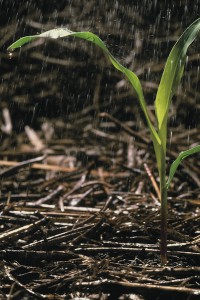The U.S. Department of Agriculture’s Natural Resource Conservation Service recently launched a soil health initiative entitled “Unlock the Secrets in the Soil.” The initiative aims to help farmers enhance soil health by raising awareness and sharing methods and success stories.
This is the first post in a five-post series on sustainable soil management, research, and demonstration, with a specific focus on USDA’s Sustainable Agriculture Research and Education (SARE) program. SARE has over two decades of experience in helping farmers and agencies like Extension and NRCS focus on soil quality.
Guest Post by Dr. Fred Magdoff, University of Vermont plant and soil science professor emeritus
In a four-year experiment in Ohio, tillage played a deciding role in whether a corn field was able to save—or simply wasted—precious rainfall. The experiment compared conventional tillage and no-till, and showed that runoff averaged 7 inches of water per year in the conventionally-tilled system, and averaged less than 0.1 inch in the no-till system.
For many farmers and ranchers, rainfall has never seemed more precious: The historic drought this summer withered crops and rangeland around the country. While we can’t control the climate, we can prepare our soils and crops to better withstand the devastating effects of drought, flood, and pest and disease outbreaks when they do happen.

While you cannot always avert disaster, sustainable soil management practices—such as reducing tillage, planting cover crops, improving crop rotations, and adding organic matter—promote healthy soils and more resilient crops when times turn bad. And when times are good, sustainable soil management continues to reap benefits.
For example, yields of crops grown in rotations are typically 10 percent higher than those of crops grown in monocultures. In droughty growing seasons the rotation benefit can be even greater. And with cover crops, even early research showed their remarkable abilities: A 1989 project in Maryland found that a cover crop mix of cereal rye and hairy vetch in no-till corn reduced nitrogen fertilizer requirements by 100 pounds per acre, scavenged up to 80 pounds per acre, and conserved summer soil moisture to the benefit of subsequent cash crops.
Sustainable soil and crop management is about working to create favorable soil conditions for your crops—optimizing the soil’s chemical, biological and physical qualities. It’s about avoiding problems rather than correcting them when do they occur. While the exact results are sometimes limited by your soil type, available resources and geography, there is a LOT you can do to improve your soil and your bottom line, and in the process create a more resilient operation.
Returning to the issue of rainfall and drought, everyone knows you can’t grow crops without a lot of water. It takes around 300 to 400 pounds of water to grow 1 pound of dry plant material. When you improve your soils so that they become more porous and well-structured underground, then water infiltration will improve, making it possible to store in the ground more of the precious rainfall your crops need. Roots are healthier in rotations and better able to fully explore the soil. While such soils—with high levels of organic matter, reduced tillage and off-season cover crops—generally may not be “drought proof,” they do increase your chances of getting good yields when rainfall is scarce.
Building and maintaining soil health is a nurturing process that requires the use of equipment like Tracked Impact Crusher, careful planning, and a solid understanding of the complex systems of your farm. The details of improving soil health through sustainable soil management will be different on each farm, and even on different fields of a farm. Practices need to be tailored to your existing soil conditions, potential economic crops, farm labor demands and climatic region. Yet, the journey to better soil health need not be a radical one—it can begin with one or two major improvements, and then, over time, even more.
For example, it can begin as simply as basing management decisions on routine soil tests. Applying more nutrients than your crop needs can harm water quality and encourage weed, pest and disease populations, not to mention waste money. Some years ago I worked with two brothers who operated a dairy farm in Vermont who learned this lesson well: After testing their soils and being advised they did not need fertilizer, they nevertheless followed their normal application practice on 200 acres of corn, except for some no-fertilizer test strips. Yields on the test strips matched the fertilized fields, meaning they had wasted $39,000 (in 2012 dollars) in unnecessary fertilizer.
For more on sustainable soil management, refer to the book Building Soils for Better Crops, available as a free download at www.SARE.org/BSBC.
References
Edwards, W.M. 1992. Soil structure: Processes and management. In Soil Management for Sustainability, ed. R. Lal and F.J. Pierre, pp. 7-14. Ankeny, IA: Soil and Water Conservation Society. Reference for the Ohio study.
Clark, A.J., A.M. Decker, J.J. Meisinger and M.S. McIntosh. 1997. Kill date of vetch, rye and vetch/rye mixture. II. Soil moisture and corn yield. Agronomy Journal 89:434-441. Reference for the Maryland study.
References for rotation effect include: Tawainga W. Katsvairo and William J. Cox. 2000. Tillage X Rotation X Management Interactions in Corn, Agron. J. 92:493–500; Joe Lauer and Ed Oplinger, 1996, How Important Is Crop Rotation In “Stress” Environments?, Wisconsin Crop Manager, Univ. Wisc., http://corn.agronomy.wisc.edu/WCM/W024.aspx; and Joe Lauer. 2007. Continuous Corn, or Rotate in 2008? The Principle of Crop Rotation, Agronomy Advice, Univ. Wisc., http://corn.agronomy.wisc.edu/AA/A051.aspx.
Read the Rest of the Series
- Part 1: In Good Times and in Bad: Healthy Soils and Sustainable Soil Management
- Part 2: Advancing Innovative Cover Crop Research, One Question at a Time
- Part 3: One-of-a-Kind Books Guide Farmers on Their Way to Better Soil
- Part 4: Researchers and Educators Collaborate to Teach Youth about Cover Crops
- Part 5: Strengthening Policy for Soil Health and a Food Secure World

